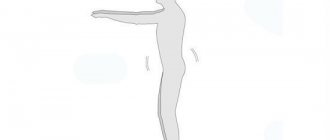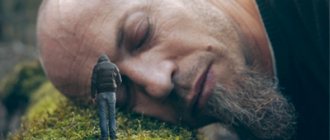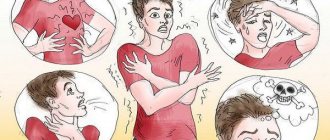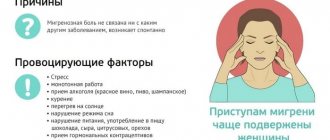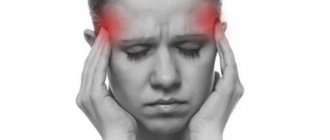Doctors Cost
Price list Doctors clinic
Pain in the occiput (back of the head) can be caused by a variety of reasons. Some of them require careful attention and serious treatment. Therefore, if cephalalgia occurs periodically, you should not limit yourself to taking painkillers, even if they are constantly advertised.
You need to make an appointment with a neurologist or therapist if your pain:
- strongly expressed
- lasts 5 days or more,
- is constantly growing,
- combined with numbness of the face, hands, trigeminal neuralgia
- does not go away after taking an analgesic.
The back of the head hurts during a migraine. Causes and treatment
Migraine refers to a primary headache caused by pathological processes in the tissues of the brain itself. Migraine pain feels like a hoop around the head, but can also be localized in the back of the head. They develop periodically, lasting from 2 hours to several days. They can bother people of any age, but more often women 25–40 years old. Migraine is provoked by nervous tension, insufficient rest, and excessive physical activity. The attack can be relieved by taking analgesics. This should be done in the first minutes of discomfort.
Tension headaches in the back of the head. Causes and treatment
This is the most common type of cephalalgia. The reason is being in an uncomfortable position for a long time, in which the neck muscles are overstrained. The problem is for office employees who work at computers and are forced to sit with their heads bent or stretched forward. In this position, the neck muscles get tired, the blood supply to the brain is disrupted, primarily to the back of the head. The pain is low-intensity and can be easily relieved by taking painkillers. However, it gradually bothers me longer and more often. To get rid of it, you need to change your position more often, do exercises with turns and tilts of your head.
Diseases associated with the symptom
The reason why the back of the head hurts may be pathology. Diseases characterized by symptoms:
- neuralgia;
- cardiopsychoneurosis;
- hypertension;
- cervical osteochondrosis;
- migraine;
- cervical spondylosis;
- myositis - inflammation of the neck muscles;
- myogelosis;
- malocclusion;
- lymphadenitis is inflammation of the lymph nodes near the neck.
They can be detected using diagnostic tests, some tests and examinations.
The back of the head hurts when blood pressure fluctuates. Treatment
High blood pressure is indicated when values above 140/90 millimeters of mercury are recorded. WHO estimates that hypertension affects 10 to 30% of the population in different countries. Only a third of them went to see a doctor, and only a third of those who did take medications prescribed by the doctor. The rest suffer from headaches, take analgesics, but do not associate their condition with hypertension.
Arterial hypertension is divided into primary - essential and secondary, caused by the pathology of other organs and systems:
- renal,
- endocrine,
- pulmogenic,
- hemodynamic,
- central.
In this case, antihypertensive drugs help.
Headache in the back of the head with problems with the cervical spine. Treatment
A common cause of cephalgia is osteochondrosis in the cervical spine. The chronic disease is associated with deformation and thinning of the intervertebral cartilage. Provoking factors: neck injuries, vertebral displacements, physiological loss of elasticity with age, excessive physical activity, excess weight, inactivity.
At first the pain is localized in the neck, but then spreads to the back of the head. This is due to compression of the nerves and vessels carrying blood to the brain. At the first signs of the disease, you should visit a neurologist for diagnosis and recommendations. In the early stages, therapeutic massage, physical therapy, and manual therapy help.
Why does the back of my head hurt?
Migraine
With migraine, throbbing pain in the temple or forehead area is most often observed, but in some patients the attack begins with painful sensations in the back of the head, which then spread to half the head.
Characterized by nausea, loss of appetite, photophobia, intolerance to loud sounds, and an increase in symptoms against the background of any physical activity. After the episode ends, pallor, weakness, and yawning are noted. Basilar migraine is manifested by regular paroxysms that occur every few weeks or months. It is preceded by a detailed aura lasting from 5 minutes to 1 hour, including tinnitus, dizziness, ataxia, double vision, dysarthria, and a number of other symptoms. After the aura, a sharp, usually one-sided pain in the back of the head appears, which in 30% of patients is combined with nausea, vomiting, sound and light phobia.
Vascular diseases
Headache with arterial hypertension is dull, pressing or bursting, most often localized in the back of the head. Complemented by dizziness, heaviness, pulsation, tinnitus. Lethargy, weakness, nausea, and palpitations are noted. Along with primary hypertension, the manifestation is characteristic of symptomatic hypertension against the background of the following pathological processes:
- Kidney diseases
: pyelonephritis, glomerulonephritis, hydronephrosis, nephrosclerosis, amyloidosis, polycystic disease, nephroptosis, malformations. - Renovascular pathologies
: aneurysms, dysplasia, thrombosis, atherosclerosis of renal vessels, vasculitis. - CNS lesions
: intracerebral neoplasia, head injury, stroke, encephalitis, meningitis. - Endocrine disorders
: Conn's syndrome, pheochromocytoma, thyrotoxicosis, Itsenko-Cushing's disease, acromegaly. - Hemodynamic disorders
: stenosis of the carotid and vertebrobasilar arteries, sclerosis and coarctation of the aorta, aortic insufficiency. - Side effects of medications
: taking oral contraceptives, indomethacin, levothyroxine, glucocorticoids, mineralocorticoids.
In cerebral atherosclerosis, pain is detected at the initial stage, localized mainly in the back of the head or of a diffuse nature. They appear during physical or emotional stress and are combined with asthenia, sleep disturbances, and memory impairment. Cognitive and neurological disorders then come to the fore.
Spondylogenic vertebrobasilar insufficiency becomes a consequence of compression of the vertebral arteries due to injuries and degenerative diseases of the cervical vertebrae. Sharp pain in the back of the head and neck on one side suddenly occurs after an awkward movement, spreading to the temple, eye and forehead. Complemented by falls, ataxia, pronounced autonomic reactions: pallor, marbling, sweating or dry skin.
Inflammatory processes in the central nervous system
With meningitis, the pain in the back of the head is excruciating, bursting, and radiates along the back of the neck. Appears against the background of intoxication syndrome. Accompanied by an increase in muscle tone, a painful reaction to noise, light, and touch. Children may experience seizures. The clinical picture of encephalitis depends on the type of disease. Typical signs are acute development with severe hyperthermia and cerebral symptoms. Sometimes convulsions, mental disorders, paresis, and hyperkinesis are observed.
Pain in the back of the head
Traumatic injuries
Pain in the back of the head or throughout the head accompanies traumatic brain injuries of any severity. The most common TBI is concussion. Along with pain, victims complain of weakness and nausea. At the time of injury, loss of consciousness or a state of stupor is possible. With brain contusions, clinical manifestations are more pronounced, loss of consciousness is prolonged, and meningeal symptoms are detected. Focal symptoms are possible.
A fracture of the cranial vault in the area of the occipital bone is manifested by sharp, sudden local pain. Then the pain spreads, complemented by manifestations of TBI. A hematoma is detected in the damaged area, and sometimes an indentation is palpated. In victims with wounds to the back of the head, the pain is less intense, from acute to raw, accompanied by heavy bleeding.
Irradiation of pain to the back of the head can be observed with subluxations of the upper cervical vertebrae. The head is in a forced position, and when trying to move, the pain intensifies. The neck muscles are tense. Sometimes dizziness, convulsions, a feeling of goosebumps, and weakness in the limbs are observed.
Damage to the cervical spine
Cervicalgia with a transition to the occipital region is detected with cervical osteochondrosis. The pain is aggravated during movements, so patients keep their head still and turn their whole body. The symptom intensifies against the background of drafts and sleeping in an uncomfortable position. Over time, “lumbago” appears - sharp burning or throbbing pain. Paresthesia and muscle weakness are possible. With an intervertebral hernia, the manifestations are aggravated.
Pulling, shooting, burning pain in the neck and back of the head, combined with sensory disturbances and limitation of movements, are observed in patients with spinal stenosis. With spondylitis against the background of infectious diseases and autoimmune pathologies, pain in the neck, radiating to the back of the head, is combined with signs of an inflammatory process.
Occipital neuralgia
It is provoked by injuries and diseases of the cervical vertebrae, hypothermia, muscle spasms, malformations, abnormalities of the craniovertebral junction, some metabolic disorders, and rheumatic diseases. Sometimes it develops spontaneously (Arnold's neuralgia). It manifests itself as paroxysmal pain in the back of the head (usually one-sided) radiating to the ears and neck. Extremely acute, often painful, unbearable, reminiscent of an electric shock or intense pulsation.
The number of paroxysms with occipital neuralgia varies from one to several dozen per day, the duration of one episode ranges from several seconds to 1-2 minutes. Attacks develop after coughing, sneezing, sudden movements, or occur for no apparent reason. Between paroxysms, symptoms are often absent, sometimes dull aching pain and paresthesia persist.
Muscle damage
Cervical myositis develops after hypothermia or overload. First, local cervicalgia appears. Then the pain spreads to the parietal and occipital regions, the upper back. Intensifies with movement. Sometimes the cause of pain is myalgia. This condition is most often observed when an uncomfortable head position is maintained for a long time, including while working at the computer.
Heat and sunstroke
In victims of sunstroke, the headache is dull, pressing, often more pronounced in the occipital region. Combined with dizziness, drowsiness, nausea, lethargy, hyperthermia. With heatstroke, the pain in the back of the head is initially aching, bursting, and not intense. Gradually intensifies and becomes diffuse. It is accompanied by nausea, increased heart rate and breathing, heaviness in the chest, pale skin, and increased body temperature. Convulsions, psychomotor agitation, delirium, and hallucinations are possible.
Other reasons
The symptom can be detected in the following diseases:
- Anemia
. Pain syndrome is provoked by oxygen starvation of the brain and soft tissues of the neck. - Heart failure.
Systemic circulatory disorders lead to a lack of oxygen in the tissues. - Diabetes.
The symptom is observed in the first stage of hypoglycemic coma. - Erysipelas.
Severe pain is typical for erysipelas of the scalp.
Severe headaches in the back of the head due to drug addiction. Treatment
Often, patients with the development of cephalgia are limited to taking painkillers purchased independently, without consulting a doctor. Analgesics are taken unsystematically, often several times a day for weeks and months. Often a person exceeds the daily dosage of the medicine recommended by the manufacturer. The result is a paradoxical reaction. The headache disappears under the influence of the pill, but returns with renewed vigor immediately after its effect ends. A vicious circle is formed, which can only be broken by an experienced neurologist; sometimes the help of a psychotherapist is required.
Peculiarities
Pain in the back of the head can be associated with inflammatory processes, mechanical damage to tissues or pressure on them, impaired blood supply or ischemia. The reasons for this can be very diverse.
In any case, now modern medical technologies and modern methods make it possible to quickly relieve pain in the back of the head. Sometimes all you need is to buy anti-inflammatory drugs at a pharmacy at an affordable price and carry out a course of treatment in accordance with the doctor’s recommendations
Sometimes the back of the head hurts even in a healthy person of any gender and age. This may be due to the characteristics of the body. Thus, it reacts to negative external stimuli. If you can quickly relieve the pain with medications and after that the discomfort does not recur, then there is no reason to worry. In this case, the development of serious pathologies can be excluded. Dangerous is an intense headache in the back of the head, which occurs frequently.
When the back of your head hurts, you need to go to a medical facility for examination in the following cases:
- If pain persists for 5 days.
- When discomfort of varying intensity is observed in total for more than 220 days.
- In the absence of a positive reaction to taking painkillers.
- When, after taking medication, there is only slight relief for a short time.



